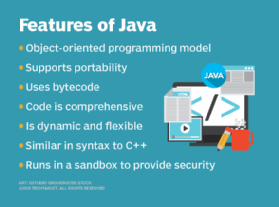
Getty Images/iStockphoto
5 reasons why Java is still the best programming language
Here's why Java is still the most popular programming language for everything from mobile development to enterprise and server-side applications that empower the middle tier.
A new, long-term support Java release is just around the corner. As Java passes the 25-year mark, let's step back and look at some of the reasons why Java remains the best programming language for modern software development.
1. Java is easy to learn
Every programming language comes with a learning curve, but Java shares many similarities with C, C++ and JavaScript. Anyone with experience in any of those languages will pick up Java syntax quickly.
Java also has a very rigid and predictable set of rules that govern code structure. This contrasts starkly with other, untyped scripting languages where it seems like anything goes. When you try to master a new programming language, a clear set of consistently enforced rules makes learning easier.
Furthermore, when things don't make sense, programmers new to Java can find a strong support network of YouTube videos, websites like StackOverflow and online forums like CodeRanch to find answers to a multitude of questions.
2. The rich set of Java APIs
The Java API is extensive. The standard JDK comes with over 200 built-in packages containing Java APIs that allow for everything from parsing XML to translating between time zones. When developers add on the Jakarta EE APIs, they have an even more extensive library of APIs that allow for the development of complex, middle-tier applications and cloud-native microservices.
But the rich ecosystem of Java APIs extends far beyond those sanctioned by Oracle or provisioned through Jakarta.
For data persistence, there's the JBoss Hibernate project. For cloud-native microservices development in Java, there's the full suite of Spring Boot APIs. And of course there's a multitude of open source Apache API projects that address a wide range of software development use cases, from aggregating error messages with log4j to solving complicated problems with HashMaps and fail-safe Iterators through the Apache Commons Collections API.
The rich set of Java APIs available to developers aid in the development of strong, error-free applications.
3. Java's tool ecosystem
The application development landscape is filled with software development tools written in Java -- by Java developers -- that are designed to simplify and streamline the development, deployment and even decommissioning of Java applications. A few examples of tools written in Java include:
- Gradle: an incredibly powerful, open source build tool
- Maven: an open source tool designed to solve dependency management problems
- Jenkins: a Java-based continuous integration and delivery tool
This is by no means an exhaustive list of Java's tool ecosystem. Other examples of tools and technologies written in Java include application servers like Tomcat to Red Hat's popular, Kubernetes-native Java stack named Quarkus.

Few other programming languages enjoy the same level of tooling support that Java does, which helps cement itself as the best programming language.
4. First-order Android Support
Android is the world's most popular mobile phone OS and Java is the de facto programming language for Android application development.
While Android's version of Java isn't exactly the same as what you'd find on the JDK, Google did copy over 11,500 lines of code from the Java Standard Edition when they built their Java clone. As a result, developers can expect that the version of Java they see on Android is pretty close to the original.
If you know can write Java code for desktop or server-side applications, you'll pick up Android development very quickly. The low-level differences between the JVM and the Dalvik Android Runtime will all be pleasantly abstracted away from you after a brief learning curve. When developers learn Java, the entire Android ecosystem will be at their disposal.
5. Forward evolution with backwards compatibility
Java evolves slowly, but it does evolve. With over 25 years of evolution, Java has plenty of evolutionary improvements to be proud about.
From the bulletproof modularity system that was delivered as part of Project Jigsaw, to the recently added ability of functional programming in Java with lambda functions, Java continues to implement big changes that the community demands.
Incremental additions in non-LTS releases, such as the the addition of the new Record data typeand garbage collectors for improved memory management, showcase that the JDK is also constantly evolving.
But in the enterprise software development world, backwards compatibility is just as important as adding new features. Java has always made this a top priority for the stewards of the language. Very rarely does a comprehensive update or feature addition create issues with code written against older releases.
I personally compiled and packaged some complicated code that was written 20 years ago, and it ran without any issues on the latest Java 17 release. When enterprise clients know that things won't break when they perform a JVM upgrade, it gives just another reason why they choose to stick with Java as the best programming language.










